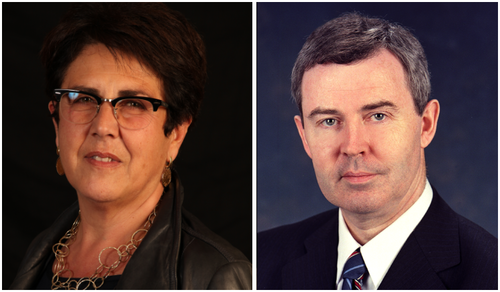The Chairs of the Sleep and Breathing 2019, Professors Maria Bonsignore (MB) and Walter McNicholas (WM), answer some questions about the upcoming conference, the final programme and what this highly anticipated event has to offer delegates.
Q: For people who are not familiar with the Sleep and Breathing conference, can you explain a little about it?
A: (MB) The Sleep and Breathing conference is the result of a collaboration between the European Respiratory Society (ERS) and the European Sleep Research Society (ESRS). It takes place bi-annually and was first launched in 2011 – making this the 5th event since it started. The overall aim of the conference has always been to bring the latest updates in sleep respiratory medicine to the growing network of interested professionals and specialists and offer them a platform for high-quality education in this field and an important opportunity to meet and discuss related topics with other professionals. The Sleep and Breathing conference, together with the new training programme developed by ERS in the last year, offers a full coverage of sleep breathing disorders (SDB) including paediatric SDB.
Q: Who is the conference aimed at and who can benefit from the programme?
A: (WM) We have taken real care in ensuring that this event is inclusive. In one respect it needs to be a must-attend event for experienced specialists in the field, offering the latest across the major topics in sleep respiratory medicine, but in another respect the conference serves an important purpose; it gives those at the beginning of their sleep medicine journey an opportunity to gain new and essential knowledge. Similarly, early career members can benefit from this conference not only for the scientific and educational opportunities available but as a great place to network with leading experts from across Europe. The conference programme also follows the Catalogue of knowledge and skills for sleep medicine from the ESRS as course material for the certification examination in somnology.
Q: How has the conference developed since it began and what does that mean for this year’s conference?
A: (MB) A key development for us over the last few years has been to create a programme that has a focus on professional development and education, which this year’s event achieves successfully. Thanks to the synergy between ERS and ESRS, the program includes updates on insomnia or restless leg syndrome, as well as organisational aspects of a modern sleep laboratory including new diagnostic technologies and the role of telemedicine.
For the first time, we also reached out to our community very early in the planning stages to get a sense of what our potential delegates really wanted to see as part of the programme – we were able to incorporate this.
Q: What topics or themes will make up the programme this year?
A: (WM) The programme will focus on respiratory sleep conditions and diseases such as: obstructive sleep apnoea, central sleep apnoea, nocturnal hypoventilation, the dental aspects of sleep-disordered breathing, and obesity hypoventilation syndrome. It will also look at diagnostic techniques, particularly polysomnography and assessment of daytime sleepiness, and telemonitoring. In terms of clinical assessment and examination, the programme will address differential diagnosis, comorbidity assessment, and the ear nose and throat aspects of sleep-disordered breathing. Treatment is also another key theme and obstructive sleep apnoea, positive airway pressure/continuous airway pressure, oral appliance therapy, and hypoventilation will all be covered in that respect. This year, we plan to link the Sleep and Breathing conference to the European Academy of Dental Sleep Medicine (EADSM), which will provide an additional benefit.
Q: (MB and WM) The final programme has just been released; what would you pick out as your personal highlights?
A: (MB)
My highlights from the programme are:
- Sleep apnoea as a risk factor for stroke and dementia
- Noninvasive ventilation or high-flow O2?
- Sleep lab or home?
- Prevalence, cardiovascular consequences and treatment of insomnia
- Challenges in oral appliance therapy for OSA
- Phenotypes and personalised treatment of OSA
- New organisation for follow-up and assessment of treatment efficacy in sleep apnoea
- Treating RLS in the context of SDB comorbidity
- Oxygen during sleep
- Gender differences in SDB
A: (WM)
I would pick out the following as my personal highlights from the programme:
- Management of Insomnia
- Driving licence issues in OSA
- Challenges in the diagnosis of OSA
- Parasomnias and sleep apnoea
- Sleep disordered breathing in chronic lung disease
The Sleep and Breathing 2019 conference takes place in Marseille, France on 11–13 April, 2019. Registration is currently open and the final programme is available.
